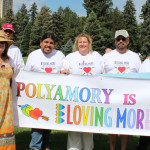 Valentine’s Day is a day to celebrate love. Kids scrawl out valentines to exchange at school. Stores are packed with cards, flowers and chocolates of every kind. Red and pink satin and lace lingerie litter the shopping malls. A day focused on couples, or at least coupling, makes it easy to forget that Love doesn’t have to be limited to only one person or that it is the exclusive domain of singular units of male-female pairings. And fortunately, this past Valentine’s Day, the Denver Westword was there to remind us that there are other options in sharing love.
Valentine’s Day is a day to celebrate love. Kids scrawl out valentines to exchange at school. Stores are packed with cards, flowers and chocolates of every kind. Red and pink satin and lace lingerie litter the shopping malls. A day focused on couples, or at least coupling, makes it easy to forget that Love doesn’t have to be limited to only one person or that it is the exclusive domain of singular units of male-female pairings. And fortunately, this past Valentine’s Day, the Denver Westword was there to remind us that there are other options in sharing love.
To recap, Jen Wohletz, writer for the Westword, profiled a polyamorous (poly) family in the Denver area: Reggie, Eeza and Cassidy. These three have lived together in a polyamorous triad for the past 6 years. Care is taken to tell an authentic story of this family and how they came together and perhaps more importantly for readers, how they currently live in the dynamic of their relationship. In addition, the relationship includes a few business ventures they have embarked on together as a team as well as a defined power exchange dynamic (Master/slave) between Reggie and Cassidy. In addition to the profile of this family, the article includes some exploration of poly a relationship model and some of the recent media attention that polyamorous dynamics have received, such as the television show Sister Wives and Polyamory: Married and Dating.
Overall, it’s an introduction to people who sincerely have a fond and close commitment to one another. And profiling one family in depth like this can be a useful tool in helping people understand the hows and whys of polyamory, putting a face or three to the overall umbrella name of the term. And it presents us with a lovely family portrait in the connections they form and the challenges they encounter together. This is their truth and it’s easy to appreciate the courage it takes to tell their story in such a public forum.
However, it’s not until you get to the “5 Myths” side article that you see more of the substance of poly and the answers to the typical questions and objections that polyamory presents. The treatment of the 5 myths lays out what I felt was missing from the article as a whole. The first myth “Polyamory is always about one man-- and multiple women” has a hard time standing on its own in the shadow of the giant profile of the very dynamic it is trying to disengage from..
 While the MFF triad isn’t the only relationship model exercised in polyamory it is very often the singular one that people dwell on to the point of enabling the myth in the first place. It often outshines the encouragement and empowerment that partners feel to define their own expectations for each dynamic they enter into, thus creating an almost limitless range of possibilities. And yet, it’s hard to imagine other configurations, especially if you’re new to the whole concept when the most popular one on display is the MFF. While the treatment of the myth is spot on (“The beauty part of poly is that the people involved get to write their own ticket, so to speak, and choose whatever dynamic works for them and their partners, and there is not solid, definable right or wrong way to do it, so long as everyone is consenting.”) readers walk away unable to conceptualize anything but that one standard.
While the MFF triad isn’t the only relationship model exercised in polyamory it is very often the singular one that people dwell on to the point of enabling the myth in the first place. It often outshines the encouragement and empowerment that partners feel to define their own expectations for each dynamic they enter into, thus creating an almost limitless range of possibilities. And yet, it’s hard to imagine other configurations, especially if you’re new to the whole concept when the most popular one on display is the MFF. While the treatment of the myth is spot on (“The beauty part of poly is that the people involved get to write their own ticket, so to speak, and choose whatever dynamic works for them and their partners, and there is not solid, definable right or wrong way to do it, so long as everyone is consenting.”) readers walk away unable to conceptualize anything but that one standard.
Profiles serve a great purpose. They provide a name and a face to polyamory that many people in the mainstream fail to ever encounter face to face. But ultimately if we want to create an atmosphere of acceptance and understanding about polyamory, people need to be able to look at these stories and see themselves in the deeper reflection. Too often, poly people are dismissed as freaks or “low self-esteem” losers who are afraid of commitment. It becomes much harder to dismiss a relationship structure if you recognize yourself within it.
I remember my first encounter with the concept of open relating: circa 1996 via Maury Povich or Jerry Springer. It was a 19 year old boy living with his baby mama and his girlfriend (MFF triad). He wasn’t anyone I would date and the piece focused so heavily on his glee over getting to watch two women make out. It felt objectifying and honestly quite shallow, not at all reflective of what I wanted for my life. So it was easy for me to dismiss it. Nevermind the fact that I would have been happier in an open relationship at the time, as I struggled to remain faithful the man I was dating. But it is easy to reject anything that doesn’t illuminate your own truth.
I wouldn’t come back to the idea until after I got married and I finally had the chance to interact with people who reflected my own reality back at me: Latino, well-educated, held a passion for social justice and public service, geeky, married, parents of young children and deeply spiritual. That’s who I am and for me to understand polyamory, I had to feel it was accessible to me. Once I was able to really get into the minds and hearts of the people behind other stories, I was able to relate and see the potential for conscious, ethical and limitless love that I had already been practicing since the time I was a kid. The face of poly had to reflect my own image back at me.
A few weeks ago I was a presenter at PolyLiving, a national conference of polyamorists. Sitting at the hotel bar on the first night, I was cornered by a couple who had been stranded at the hotel on their way to a romantic Valentine’s vacation. I did what I usually do, I explained a little bit about my story, about the basic gist of polyamory and then respond to questions.
This time I responded with something different. I focused on the fact that my relationship is determined by conscious choices my husband and I make together. Just as we make decisions about which doctor to choose for our children or how we want to spend our tax return, there are no right or wrong answers. We get to choose for ourselves, just like that couple chose for themselves where they wanted to go for a romantic getaway from the kids. By talking about the everyday decisions that any family makes and relating my family dynamics back to theirs, it helped make polyamory more accessible in their minds. They had a better understanding that authenticity is an important value and that polyamory is legitimate and sincere way for me to live with honesty. I wasn’t there to convince them, only to give them a face of poly that may connect with them on a deeper level and I’m sure that sparked many a conversation during their trip.
The way I see it, most people are attempting to emulate ideals that were taught in literature or religion or handed down to them through the advice of well-meaning family members. Or for that matter, maybe they are simply trying to avoid the disastrous examples of that same family. There is no singular standard for how to build your own relationship just as there is no single standard as to what is romantic or sexy (no chocolates or lingerie for me on Valentine’s Day please). I get to define that for myself and so do you. I’m grateful that the Westword gave us some relief from the default Valentine’s message of a “one and only” Love; I only wish we could have truly seen more of the many facets and faces of Love reflected back to us.







